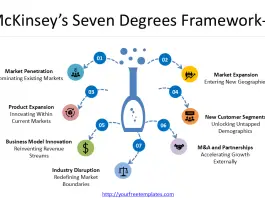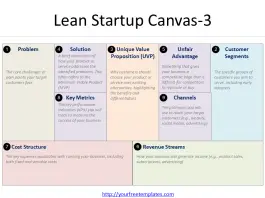The circular economy is revolutionizing the way we think about production, consumption, and waste management. This innovative approach to economic systems aims to eliminate waste, maximize resource efficiency, and promote sustainable development. As global concerns about environmental degradation and resource scarcity continue to grow, understanding the circular economy meaning has become crucial for businesses, policymakers, and individuals alike.
At the end of this post, you can download our Circular Economy PowerPoint template to fit your purpose. As the same diagram PowerPoint template series, you can also find our Blue Sea Strategy, 2025 Calendar with Holidays, The 7 Habits of Highly Effective People, Six Thinking Hats, Pareto Chart, Occam’s Razor, Data Mining, marketing segment, Porter’s five forces, SWOT Analysis, GE Matrix, BCG Matrix, Artificial Intelligence, National Diamond and BlockChain PowerPoint templates.
At its core, the circular economy is a model that challenges the traditional linear “take-make-dispose” approach. It emphasizes the importance of keeping resources in use for as long as possible, extracting maximum value from them while in use, and recovering and regenerating products and materials at the end of their service life. This concept has an impact on various aspects of our lives, from product design and manufacturing to business models and renewable energy adoption. As we delve deeper into the principles and applications of the circular economy, we’ll explore its definition, key components, and the transformative potential it holds for creating a more sustainable future.
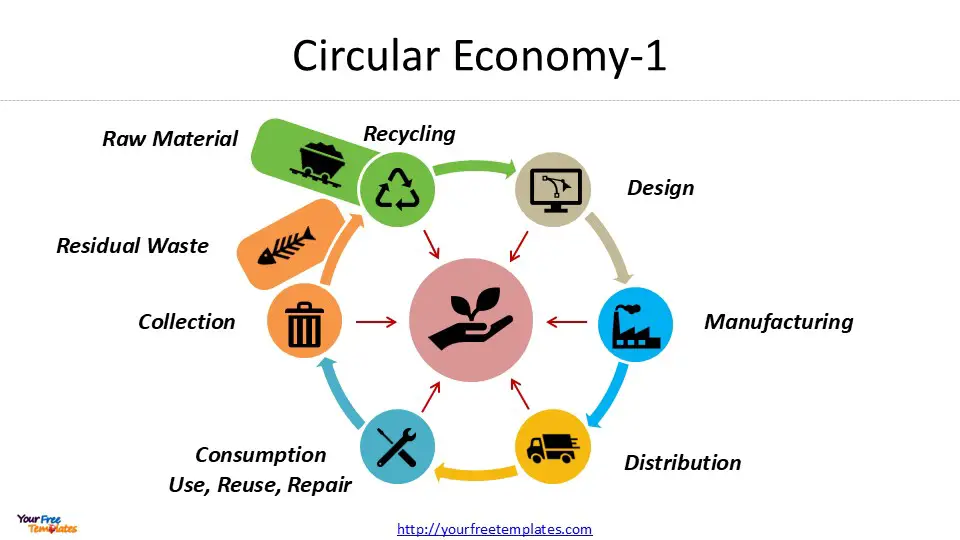
The Evolution of Economic Models
Linear Economy
The linear economy has been the dominant model since the Industrial Revolution. This traditional approach follows a “take-make-waste” pattern, where resources are extracted from the earth, transformed into products, and ultimately discarded as waste 1. In this model, businesses prioritize profit over sustainability, with little consideration for the ecological footprint of their products or their end-of-life scenarios 2.
The linear economy operates under the assumption that resources are abundant and infinite. However, this approach has put significant pressure on scarce resources and has had little concern for environmental and social impact 1. As a result, the world is currently consuming resources at a rate 1.7 times higher than the Earth’s actual capacity 3.
Recycling Economy
As awareness of environmental issues grew, the concept of recycling emerged as an intermediate step between the linear and circular economies. The recycling economy aimed to address some of the shortcomings of the linear model by introducing the practice of collecting and processing used materials to create new products.
While recycling has had a positive impact on waste reduction, it often results in downcycling, where materials are reprocessed into products of lesser value 1. This approach, while better than the linear model, still fails to fully address the challenges of resource depletion and environmental degradation.
Circular Economy
The circular economy represents a paradigm shift in how we approach production, consumption, and waste management. It challenges the traditional linear model by emphasizing the importance of keeping resources in use for as long as possible, extracting maximum value from them while in use, and recovering and regenerating products and materials at the end of their service life.
In a circular economy, the focus is on creating a regenerative system that minimizes resource inputs and emissions 4. This model builds on the principles of reuse, recycle, repair, and remanufacture, turning goods that are at the end of their lifecycle into alternative resources 3. The circular economy aims to close the loop in industrial ecosystems, ultimately eliminating the concept of waste 3.
One of the key aspects of the circular economy is its emphasis on product design. Manufacturers are encouraged to create products that are durable, easily repaired, and have accessible spare parts to support prompt maintenance 3. This approach helps extend the use of products, reducing pressure on natural resources needed to manufacture new items.
The circular economy also promotes innovative business models, such as the performance economy and the sharing economy. These models focus on providing services rather than selling products, shifting from ownership to access-based consumption 3. For example, consumers can choose to share products they only use occasionally, such as power drills or cars, instead of buying them outright 5.
By adopting circular economy principles, businesses can reduce their environmental impact, create new economic opportunities, and foster innovation. The transition to a circular economy requires collaboration between governments, companies, and consumers, as well as the implementation of strong policies and regulations to protect the environment and guide business practices 3.
As the world grapples with the challenges of climate change and resource scarcity, the circular economy offers a promising path towards a more sustainable and resilient future. By rethinking our approach to production, consumption, and waste management, we can create a system that benefits both the economy and the environment.
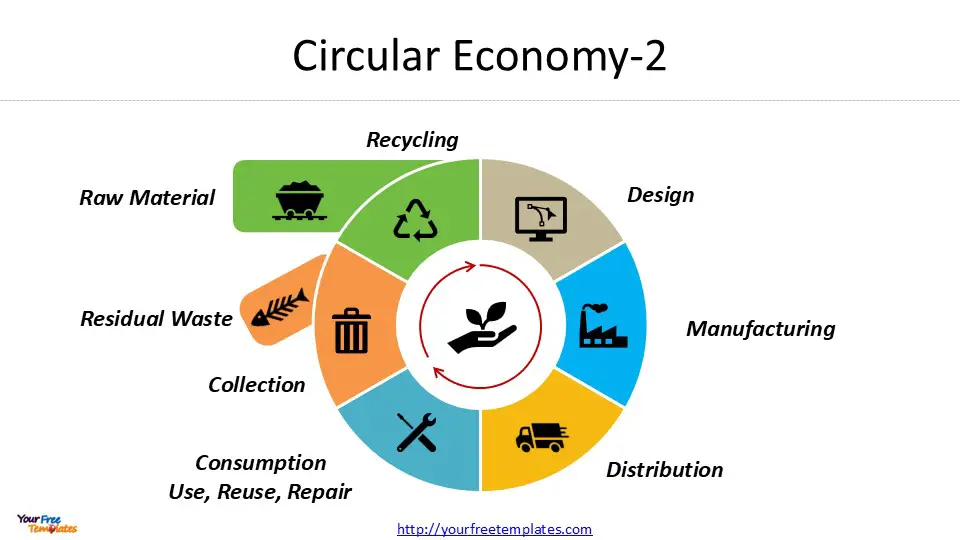
Core Principles of a Circular Economy
The circular economy is built on three fundamental principles that aim to transform the traditional linear “take-make-dispose” model into a more sustainable and regenerative system. These principles guide businesses, policymakers, and individuals in creating a more efficient and environmentally friendly approach to production, consumption, and waste management.
Eliminate Waste and Pollution
The first principle of the circular economy focuses on designing out waste and pollution from the very beginning. This approach recognizes that waste is not an inevitable byproduct of economic activity but rather a result of design choices. By changing our mindset and viewing waste as a design flaw, we can create products and systems that minimize or eliminate waste altogether.
In a circular economy, businesses are encouraged to rethink their product designs and manufacturing processes to reduce resource consumption and prevent pollution. This can involve using renewable materials, developing products that are easily repaired or upgraded, and implementing cleaner production techniques.
For example, companies like Apeel have developed innovative solutions to eliminate single-use plastic packaging for fresh produce. Their edible, plant-based coating extends the shelf life of fruits and vegetables without the need for plastic wrap, effectively reducing both food waste and plastic pollution.
Circulate Products and Materials
The second principle emphasizes keeping products and materials in use for as long as possible. This involves designing products for durability, reusability, and recyclability, as well as creating systems that support the circulation of these materials within the economy.
Circular business models play a crucial role in this principle. These models focus on providing services rather than selling products, shifting from ownership to access-based consumption. For instance, sharing platforms like OLIO allow neighbors to share surplus food, reducing waste and optimizing resource use.
Companies are also adopting strategies to extend product lifecycles through repair, refurbishment, and remanufacturing. IKEA, for example, is working towards producing 100% circular products by using materials that can be easily recycled or repurposed, such as solid wood and veneer products that can be disassembled for repair or refurbishment.
Regenerate Nature
The third principle of the circular economy goes beyond simply reducing negative impacts on the environment. It aims to actively regenerate natural systems and build natural capital. This principle recognizes that human economic activities can have a positive impact on nature when designed thoughtfully.
In the food industry, regenerative farming practices are gaining traction. These methods focus on improving soil health, increasing biodiversity, and reducing reliance on synthetic inputs. By adopting practices such as agroforestry and conservation agriculture, farmers can produce food while simultaneously restoring ecosystems and enhancing natural habitats.
The economic, health, and environmental benefits of a circular economy for food alone could be worth USD 2.7 trillion a year by 2050 6. Moreover, by adopting circular economy principles, the food industry could potentially halve its projected greenhouse gas emissions by 2050 6.
Beyond agriculture, companies are finding innovative ways to regenerate nature through their business practices. GreenWave’s 3D ocean farming method, for example, produces shellfish and seaweeds in a nature-positive way, restoring marine ecosystems while providing sustainable products for various industries.
By embracing these three core principles, the circular economy offers a promising path towards a more sustainable and resilient future. It challenges businesses and individuals to rethink their approach to production, consumption, and waste management, creating a system that benefits both the economy and the environment.
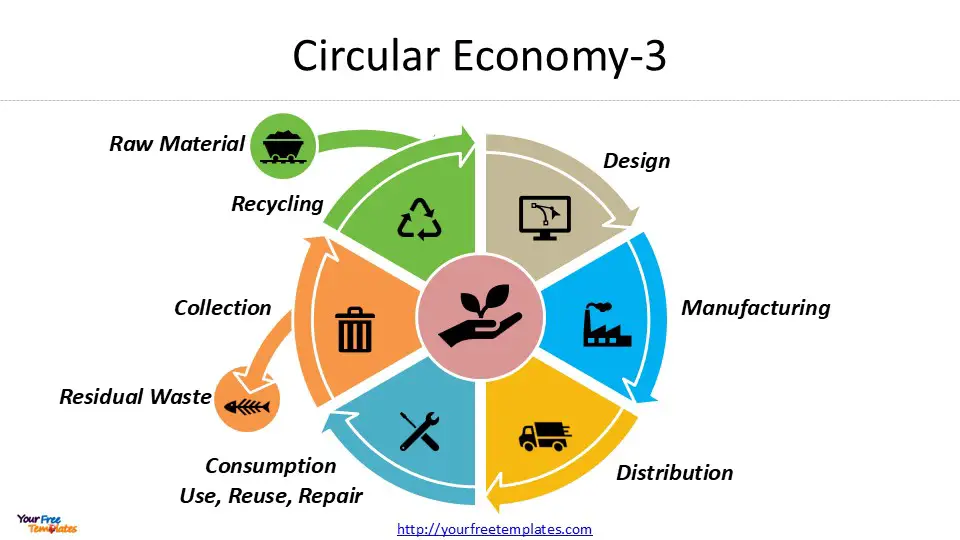
Circular Economy in Action
The circular economy is transforming industries and businesses worldwide, offering innovative solutions to reduce waste and maximize resource efficiency. This approach has an impact on various aspects of production and consumption, from product design to sharing economy models and reverse logistics.
Product Design
Designing products with circularity in mind is crucial for establishing more sustainable systems. The core focus of circular product design is to design out waste, removing unnecessary elements that use materials and generate waste 7. Companies are now prioritizing two main themes to extend product lifetimes: design for durability or design for repair and reuse 7.
For instance, Dutch phone company Fairphone designs its smartphones with a modular construction, allowing consumers to easily repair or replace parts 8. This approach not only extends the product’s lifespan but also creates new business opportunities in the form of service and repair offerings 9.
By adopting circular principles, producers have a vested interest in preserving the product’s lifetime and performance. This opens up new revenue streams through models like product-as-a-service (PaaS) and resale models, which were previously not viable due to a disconnect in the value chain 9.
Sharing Economy
The sharing economy plays a significant role in promoting circular economy principles. It allows individuals to access goods and services without owning them outright, leading to more efficient use of resources and reduced waste 10. This model has given rise to new business opportunities in various industries, including transportation, lodging, and finance 10.
For example, companies like Turo and Zipcar are promoting the idea of access over ownership in major American cities 11. These sharing platforms enable collaborative consumption through lending, swapping, bartering, and renting of products, helping to overcome inefficiencies of a linear economy 12.
The sharing economy can contribute to sustainable development by changing the way customers purchase and make decisions. It echoes the ideas behind environmentally friendly behaviors, based on the concept that any underutilized resource is a wasted opportunity 12.
Reverse Logistics
Reverse logistics is a critical component of the circular economy, encompassing the process of moving goods from their typical final destination for the purpose of capturing value or proper disposal 13. This process includes activities such as remanufacturing, refurbishing, recycling, and proper disposal of products 13.
In the context of a circular economy, reverse logistics plays a crucial role in closing the loop. It enables firms to develop circular product designs, mitigate waste by combining reverse and forward flows, and increase the return rate of used products for recycling 13.
Technological advances, such as big data and the Internet of Things (IoT), are enhancing reverse logistics capabilities. These innovations help trace products, reducing waste and improving the efficiency of the circular economy 13.
Companies are increasingly recognizing the importance of reverse logistics in their circular business models. For instance, Xerox provides protective packaging for returns that require no tape, facilitating customer and distributor returns 13. Similarly, Komatsu, a manufacturer of construction and mining equipment, has fitted all standard equipment with sensors that collect data on their condition, allowing for quick identification of components that can be reconditioned or recycled 13.
As businesses continue to embrace circular economy principles, the integration of innovative product design, sharing economy models, and efficient reverse logistics will be crucial in creating a more sustainable and resource-efficient future.
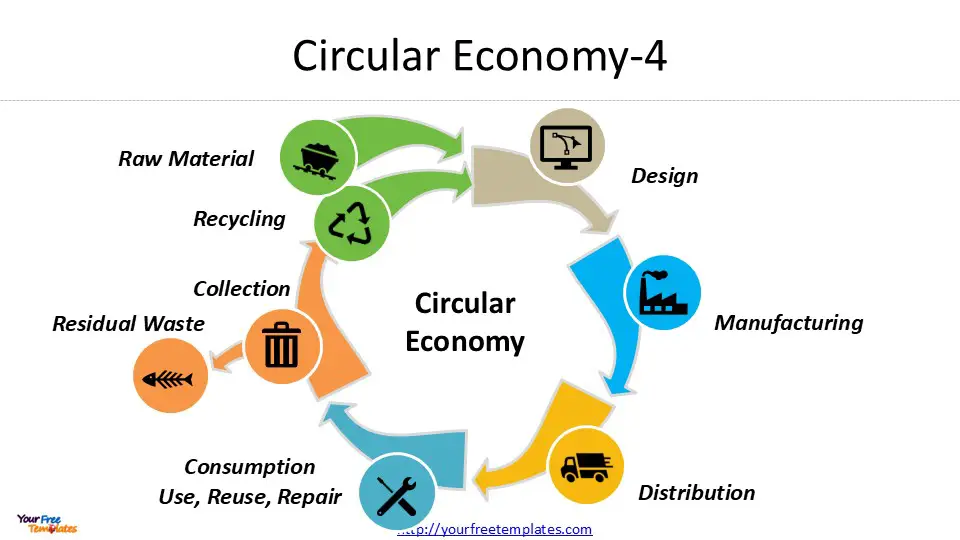
Industries Embracing Circularity
Manufacturing
The manufacturing sector has substantial growth opportunities in adopting circular economy principles. Companies are realizing that materials from end-of-life products still hold value, which can be recaptured by rethinking the entire production process. This shift towards circular manufacturing is expected to create a market worth USD 553 billion in 2023, with a projected compound annual growth rate of 13.19% by 2030 14.
Manufacturers are tapping into emerging technologies to improve their systems, using less virgin material and producing less waste. This approach not only reduces environmental impact but also achieves significant material cost savings of USD 700 billion annually by avoiding the expense of extracting and processing virgin natural resources 14.
One example of circular manufacturing is Contec, a company that transforms end-of-life tires into reusable commodities. Using a process called pyrolysis, Contec recovers about 85% of materials from discarded tires in the form of Carbon Black (ConBlack), oil (ConPyro), and steel (ConWire) 14. This innovative approach not only reduces waste but also creates valuable products for various industries.
Fashion
The fashion industry is making strides towards circularity, challenging the traditional linear “take-make-dispose” model. Companies are focusing on designing clothes for longevity, repairability, and recyclability. This shift is not only environmentally beneficial but also presents significant economic opportunities. By moving to a circular system, the fashion industry can unlock a USD 560 billion economic opportunity 15.
Innovative business models are emerging within the industry. For instance, rental models provide customers with access to a variety of clothes while decreasing the demand for new clothing production. Companies like MUD Jeans offer high-quality denim through rental services, while Vigga provides subscriptions for baby wear 15.
The resale market is also growing rapidly, with resale growing 21 times faster than retail over the past five years 15. This trend is supported by partnerships between established brands and resale platforms, such as Stella McCartney’s collaboration with The RealReal and Reformation’s partnership with ThredUp.
Food and Agriculture
The food and agriculture sector is leveraging circular economy solutions to reduce waste, mitigate packaging waste, and generate energy. Some food businesses are using end-of-life and surplus products as ingredients for other food products, such as beer. Food waste is also being used to generate bioenergy through anaerobic digestion, providing a renewable energy source 16.
Regenerative farming techniques are gaining traction, improving soil health, enhancing biodiversity, and sequestering carbon. These practices not only improve the productivity and resilience of the land over time but also decrease reliance on external inputs 16.
In livestock farming, there’s an increasing movement towards integrating animals into cropping systems to form mixed farming systems. This approach, along with upcycling agricultural side streams into animal feeds, reduces the need for cultivation specifically for feed production 16.
The concept of ‘closing the loop’ is being applied to waste management in agriculture. Organic waste, such as manure and crop residues, is composted and returned to the soil as nutrient-rich amendments, rather than being discarded 16. This practice not only reduces waste but also enhances soil fertility, contributing to a more sustainable and circular agricultural system.
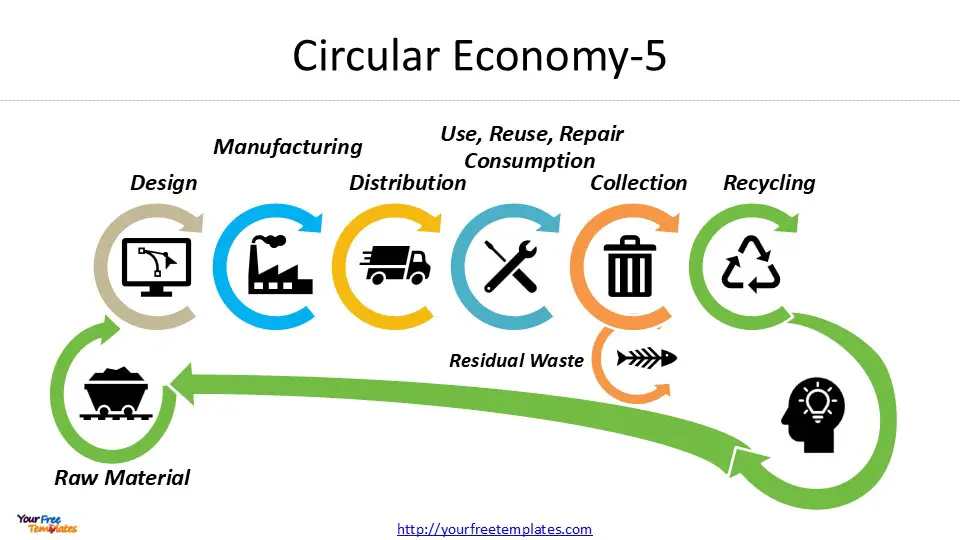
Global Initiatives and Policies
As the concept of circular economy gains traction worldwide, governments and international organizations are implementing policies and initiatives to promote sustainable development and resource efficiency. These efforts aim to address global challenges such as climate change, waste management, and resource depletion.
EU Circular Economy Action Plan
The European Union has taken a leading role in promoting circular economy principles through its Circular Economy Action Plan (CEAP). Adopted in March 2020, the CEAP is a cornerstone of the European Green Deal, which aims to make Europe the first climate-neutral continent by 2050 17. This comprehensive plan introduces legislative and non-legislative measures targeting various sectors and stages of product lifecycles.
The CEAP focuses on making sustainable products the norm in the EU, empowering consumers and public buyers, and addressing sectors that use the most resources and have high circularity potential. These sectors include electronics, batteries, vehicles, packaging, plastics, textiles, construction, and food 17. By implementing these measures, the EU aims to reduce waste, create sustainable growth and jobs, and contribute to achieving its climate neutrality target.
China’s Circular Economy Promotion Law
China has been at the forefront of circular economy implementation, introducing its Circular Economy Promotion Law in 2008 18%20Circular%20Economy%20Promotion%20Law%20(2008).pdf). This law aims to facilitate circular economy practices, raise resource utilization rates, protect the environment, and promote sustainable development. It defines circular economy as activities involving decrement, recycling, and resource recovery in production, circulation, and consumption 18%20Circular%20Economy%20Promotion%20Law%20(2008).pdf).
The law emphasizes comprehensive planning, reasonable layout, and taking measures according to local conditions. It also promotes government support, market orientation, enterprise implementation, and public participation 18%20Circular%20Economy%20Promotion%20Law%20(2008).pdf). China’s approach to circular economy has evolved over time, with recent policies focusing on improving resource productivity, addressing water and air pollution, and tackling climate change 19.
UN Sustainable Development Goals
The United Nations Sustainable Development Goals (SDGs) provide a framework for global action towards a more sustainable future. While not explicitly focused on circular economy, many of the SDGs align closely with circular economy principles. For instance, SDG 12 (Responsible Consumption and Production) is particularly relevant to circular economy practices, promoting sustainable consumption and production patterns, reducing waste generation, and optimizing resource use 20.
Other SDGs that benefit from circular economy approaches include SDG 9 (Industry, Innovation, and Infrastructure), SDG 11 (Sustainable Cities and Communities), SDG 7 (Affordable and Clean Energy), SDG 13 (Climate Action), and SDG 6 (Clean Water and Sanitation) 20. By adopting circular economy principles, countries and organizations can contribute to achieving multiple SDG targets simultaneously.
The World Economic Forum’s circular economy initiative, Consumers Beyond Waste, aims to reduce plastic waste by promoting reusable packaging 21. Similarly, the United Nations Environment Program (UNEP) and the International Solid Waste Association (ISWA) have published the Global Waste Management Outlook 2024, which emphasizes the critical role of circular economy approaches in minimizing waste and addressing environmental challenges 21.
As these global initiatives and policies demonstrate, the circular economy is increasingly recognized as a powerful framework for addressing environmental, economic, and social challenges. By promoting resource efficiency, waste reduction, and sustainable business models, these efforts aim to create a more resilient and sustainable global economy.
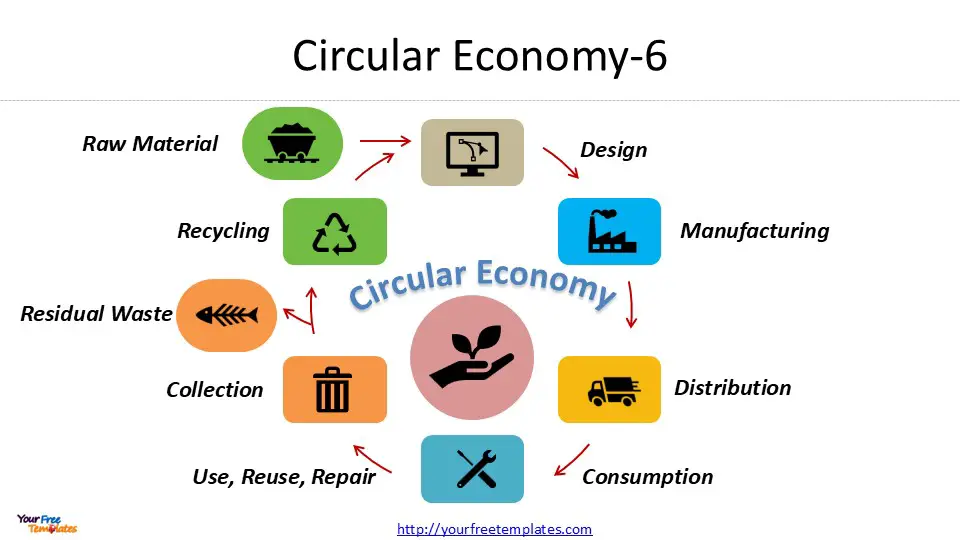
Conclusion
The circular economy has a profound influence on how we approach production, consumption, and waste management. By focusing on eliminating waste, keeping resources in use, and regenerating natural systems, this model offers a promising path to tackle environmental challenges and create economic opportunities. The principles of circular economy are reshaping industries, from manufacturing and fashion to food and agriculture, leading to innovative business models and more sustainable practices.
As global initiatives and policies continue to promote circular economy principles, we’re seeing a shift towards a more resilient and sustainable future. The EU’s Circular Economy Action Plan, China’s Circular Economy Promotion Law, and the alignment with UN Sustainable Development Goals show the growing recognition of circularity’s importance. To move forward, it’s crucial for businesses, governments, and individuals to embrace these principles, rethinking our approach to resources and waste to create a more sustainable world for future generations.
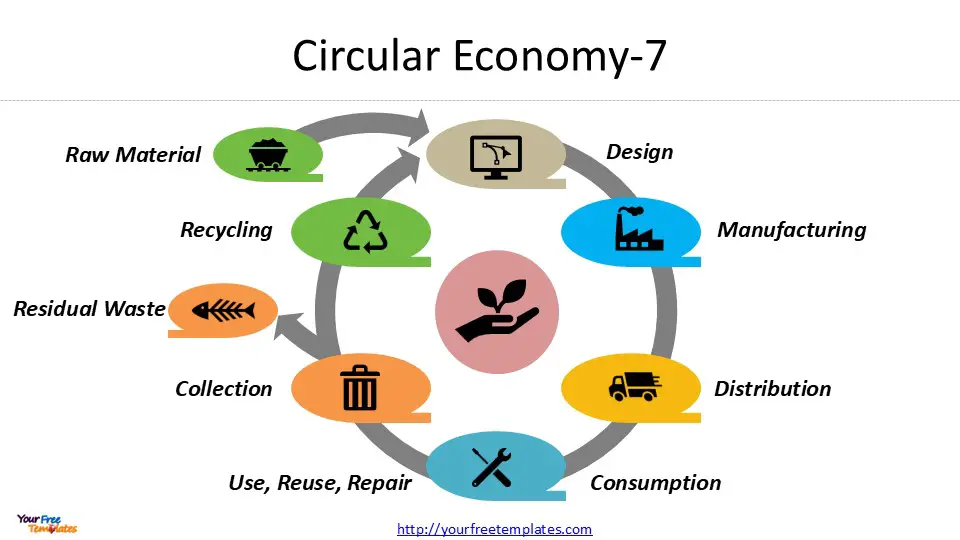
FAQs
What are the fundamental principles of a circular economy?
The circular economy is built on four key principles, often referred to as the 4 Rs: reduce, reuse, recycle, and recover. These principles aim to maintain the value of products, materials, and resources for as long as possible by minimizing waste and resource use.
Can you detail the three main components of the circular economy?
The circular economy is structured around three core components: eliminating waste and pollution, keeping products and materials in use at their highest value, and regenerating natural systems. Each of these principles focuses on designing out waste and pollution, maintaining the utility of products and materials, and enhancing natural resources.
How would you define a circular economy?
A circular economy is a systemic approach to economic development designed to benefit businesses, society, and the environment. In contrast to the ‘take-make-waste’ linear model, a circular economy is regenerative by design and aims to gradually decouple growth from the consumption of finite resources.
What is the significance of the circular flow in economics?
The circular flow model is a conceptual tool used to understand the interactions between the main actors in the economy—households and businesses. It illustrates how money, goods, and services move through the economy, helping to demonstrate how these different entities interconnect.
Need premium maps, pls visit our map shop: https://editablemaps.com https://ofomaps.com
Size:160K
Type: PPTX
Circular Economy Template
Click the link to download it.
Aspect Ratio: Standard 4:3
Click the blue button to download it.
Download the 4:3 Template
Aspect Ratio: Widescreen 16:9
Click the green button to download it.
Download the 16:9 Template
References
[1] – https://contec.tech/linear-economy-vs-circular-economy-differences-how-to-make-the-change/
[2] – https://www.greenify-me.com/2023/01/linear-economy-vs-circular-economy.html
[3] – https://www.researchgate.net/publication/336243057_Transition_from_Linear_to_Circular_Economy
[4] – https://link.springer.com/article/10.1007/s00191-020-00709-0
[5] – https://www.government.nl/topics/circular-economy/from-a-linear-to-a-circular-economy
[6] – https://www.sciencedirect.com/science/article/pii/S2212827117301567
[7] – https://www.inogenalliance.com/blog-post/core-principles-circular-economy
[8] – https://blog.worldfavor.com/closing-the-loop-6-essential-steps-for-implementing-circular-economy
[9] – https://www.circularize.com/blogs/circular-product-design-and-business-models
[10] – https://incorporate.ee/sustainability/circular-economy-and-sharing-economy-building-a-sustainable-future-together/
[11] – https://eassetsolutions.com/best-7-circular-economy-examples/
[12] – https://www.researchgate.net/publication/321677578_Sharing_economy_and_circular_economy_How_technology_and_collaborative_consumption_innovations_boost_closing_the_loop_strategies
[13] – https://www.circulareconomyasia.org/reverse-logistics/
[14] – https://contec.tech/circular-economy-examples-manufacturing-industry/
[15] – https://www.ellenmacarthurfoundation.org/fashion-and-the-circular-economy-deep-dive
[16] – https://www.startus-insights.com/innovators-guide/circular-economy-examples/
[17] – https://environment.ec.europa.eu/strategy/circular-economy-action-plan_en
[18] – https://www.greenpolicyplatform.org/sites/default/files/downloads/policy-database/CHINA)%20Circular%20Economy%20Promotion%20Law%20(2008).pdf
[19] – https://circulareconomy.europa.eu/platform/sites/default/files/2023-08/China%E2%80%99s%20Circular%20Economy%20Policies_%20Review%20and%20Reflection.pdf
[20] – https://sdg-action.org/advancing-the-global-agenda-through-adopting-circular-economy/
[21] – https://www.weforum.org/agenda/2024/04/circular-economy-waste-management-unep/
